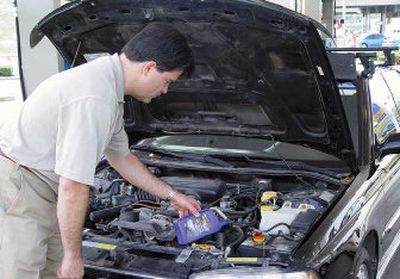Car care now avoids worse winter problems

The cooler days of fall are an excellent time to prepare your car for the potential ravages of winter. According to the experts at the nonprofit National Institute for Automotive Service Excellence (ASE), “Cold weather will only make existing problems worse.” That’s why a few minutes in the garage this fall could help prevent a much more time-consuming and unpleasant experience this winter.
Here are a few items that are easy and simple to check before fall turns to winter. (Always read your owner’s manual, and follow the manufacturer’s recommended service schedules. No one knows your car better than the company that manufactured it.)
• Motor oil: The easiest way to protect and improve the performance of your car is to upgrade to a high-performance synthetic motor oil, and change it regularly. Synthetic motor oils have better low-temperature fluidity and a lower coefficient of friction than mineral-based motor oils. This will help ensure easier start-ups on cold-weather days. Some motor oils offer continuous engine protection and improve fuel economy, reduce emissions and increase horsepower and torque.
• Tires: Worn tires can be extremely dangerous on rainy, snowy and icy terrain and roads. Examine tires’ tread life and wear. Be sure to check the sidewalls for cuts and nicks as well. All-season radials or winter tires are a wise investment for those who must regularly drive in inclement weather. Check tire pressure and rotate as recommended. Don’t forget to check your spare, and be sure the jack functions properly.
•Cooling system: The level, condition and concentration of the coolant should be checked periodically. It may be time for a flush and refill if it’s been more than a couple of years since the coolant has been changed. A 50/50 mix of antifreeze and water is usually recommended. Additionally, hoses should be checked for cracks and leaks.
• Windshield wipers: Check the condition of your wiper blades, and replace them if needed. If your climate is harsh, purchase rubber-clad, winter blades to fight ice build-up. Stock up on winter-formula windshield washer solvent. You’ll be surprised by how much you use. If you don’t have an ice-scraper, buy one and stash it in your backseat or trunk.
• Battery: A dead battery can make a cold winter morning miserable. If your battery is beyond its recommended service life, replace it. Top any low battery cells with distilled water. Clean and tighten battery terminals to ensure electricity gets from the battery to the starter on chilly fall mornings. If corrosion is present, clean it with a mixture of baking soda and water, and put on a set of battery washers to keep corrosion from returning. Make sure the battery terminals and hold-downs are tight. It’s also good to clean and lubricate hinges and the hood latch.
• Fuel: It’s important to keep gas lines from freezing in cold weather. No vehicle can run if it can’t get fuel. A full gas tank will help prevent moisture and ice from forming. Particularly cold weather may warrant using a fuel de-icer or block heater to prevent fuel lines from freezing.
• Properly preparing your car for winter is simple and doesn’t require a lot of time or technical expertise. The payback in reduced risk of a preventable breakdown and improved performance is well worth the minimal effort.